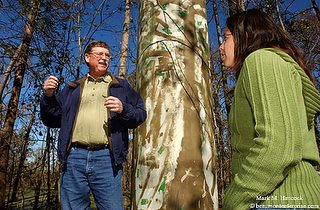As we saw last year, this also significantly effected life itself in the bayou. While it would be easy to see the destruction as a reason to quit, the center's leaders have viewed everything as "best" and worked to adjust their plans.
The center will still open in the spring of 2007. The storm actually resolved disputed issues such as parking areas. Many parking area trees were removed by the hurricane. All remaining trees get to stay.
The adaptability of the center's staff is amazing considering the massive damage inflicted on the area. They view the storms as a natural part of a living forest. The strongest survived. Now, they can study the survival and regeneration process of a living forest and its ecosystems. From this perspective, the center is on track to be an educational magnet for years to come.

Photos by Mark M. Hancock / © The Beaumont Enterprise
A turtle shell rests in a birding blind at Shangri La Botanical Gardens and Nature Center in Orange on Friday, Jan. 6, 2006. The center, which was seriously damaged by Hurricane Rita, still plans to spend millions of dollars to restore and open in 2007.

Remaining leaves continue to change color at Shangri La Botanical Gardens and Nature Center in Orange. Administrators expect the finished 252-acre center will be a tourist destination similar to Moody Gardens in Galveston.

A trumpet creeper plant changes color at Shangri La Botanical Gardens and Nature Center in Orange.

Shangri La Botanical Gardens & Nature Center executive director Michael Hoke talks with intern Leticia Villarreal, a wildlife management graduate from Michigan State, in front of an experimental bat shelter at the center in Orange. The bat shelter is a project to protect the endangered Rafinesque's big-ear bat (Plecotus rafinesquii). Unlike similar bats, this bat roosts in hollow trees instead of caves.

The lake ecosystem provides educational opportunities at Shangri La Botanical Gardens and Nature Center in Orange.

A 1,229-year-old pond cypress known as "The Old Survivor" remains at Shangri La Botanical Gardens and Nature Center. Information contained within the tree speaks of its surviving several strong hurricanes in addition to Rita.

Thousands of trees were destroyed in the 252-acre Shangri La Botanical Gardens and Nature Center in Orange.
Please read "Rebuilding paradise" by Jamie Reid.


No comments:
Post a Comment